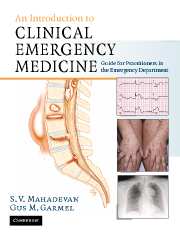Book contents
- Frontmatter
- Contents
- List of contributors
- Foreword
- Acknowledgments
- Dedication
- Section 1 Principles of Emergency Medicine
- Section 2 Primary Complaints
- Section 3 Unique Issues in Emergency Medicine
- 41 Child abuse, elder abuse, intimate partner violence
- 42 Environmental emergencies
- 43 Ethics and end-of-life issues
- 44 Legal aspects of emergency care
- 45 Occupational exposures in the emergency department
- Section 4 Appendices
- Index
44 - Legal aspects of emergency care
Published online by Cambridge University Press: 27 October 2009
- Frontmatter
- Contents
- List of contributors
- Foreword
- Acknowledgments
- Dedication
- Section 1 Principles of Emergency Medicine
- Section 2 Primary Complaints
- Section 3 Unique Issues in Emergency Medicine
- 41 Child abuse, elder abuse, intimate partner violence
- 42 Environmental emergencies
- 43 Ethics and end-of-life issues
- 44 Legal aspects of emergency care
- 45 Occupational exposures in the emergency department
- Section 4 Appendices
- Index
Summary
Scope of the problem
Emergency physicians interact with various aspects of the legal system throughout their career. Along with a relatively high likelihood of malpractice claims, emergency physicians often interact with police as they assess and treat trauma patients. They must also routinely deal with complicated legal issues such as advance directives, informed consent, protection of minors, mandatory reporting to health authorities, involuntary confinement, and compliance with federal laws, such as the Emergency Medical Treatment and Active Labor Act (EMTALA).
This chapter introduces the most common legal concepts that arise in emergency medicine. It begins with a discussion of legal issues that develop during patient care, followed by a review of physician interactions with the criminal justice system, providing care under the EMTALA, and finally medical malpractice. The difficulty with any discussion of legal issues on a general level lies in the lack of consistency between the various legal systems. Broadly speaking, there are two main divisions – federal law and state law – and each of these divisions is further subdivided into criminal, civil, and administrative sections. The laws governing any particular issue may differ depending on the particular state involved (or the federal government) and whether criminal, civil, or administrative rules apply. This inconsistency results in a certain ambiguity when discussing legal issues in a general sense, and mandates that physicians understand the specific laws that govern in their practice location.
- Type
- Chapter
- Information
- An Introduction to Clinical Emergency MedicineGuide for Practitioners in the Emergency Department, pp. 661 - 668Publisher: Cambridge University PressPrint publication year: 2005

